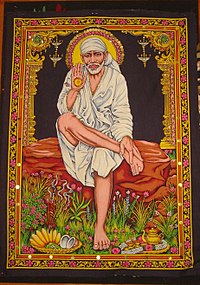
Sai Baba of Shirdi (Unknown - October 15, 1918), also known as Shirdi Sai Baba, was an Indian guru and yogi who is regarded by both his Hindu and Muslim followers as a saint. Some of his Hindu devotees believe that he was an incarnation of Shiva or Dattatreya.There are many stories and eyewitness accounts of miracles he performed. He is a well-known figure in many parts of the world, but especially in India, where he is much revered.
The name 'Sai Baba' is a combination of Persian and Indian origin; Sāī (Sa'ih) is the Persian term for "holy one" or "saint", usually attributed to Islamic ascetics, whereas Bābā is a word meaning "father" used in Indo-Aryan languages. The appellative thus refers to Sai Baba as being a "holy father" or "saintly father". His parentage, birth details, and life before the age of sixteen are obscure, which has led to a variety of speculations and theories attempting to explain Sai Baba's origins. In his life and teachings he tried to reconcile Hinduism and Islam: Sai Baba lived in a mosque, was buried in a Hindu temple, practised Hindu and Muslim rituals, and taught using words and figures that drew from both traditions. One of his well known epigrams says of God: "Sabka Malik Ek" ("One God governs all") which traces its root to Islam in general and sufism in particular.
Sai Baba taught a moral code of love, forgiveness, helping others, charity, contentment, inner peace, devotion to God and guru. His teachings combined elements of Hinduism and Islam and tried to achieve communal harmony between these religions.
Sai Baba remains a very popular saint and is worshiped by people around the world. Debate over his Hindu or Muslim origins continues to take place. He is also revered by several notable Hindu and Sufi religious leaders. Some of his disciples received fame as spiritual figures and saints such as Upasni Maharaj and Meher Baba.
Sai Baba’s origin is completely unknown to this day. He did not disclose to anyone where he was born nor where he grew up. Because of his unknown past, various communities have claimed that he belongs to them. Nothing has been substantiated, however. It is known that he spent considerable period with fakirs. His attire resembled that of a Muslim fakir. He regularly visited mosques and ate meat as well.[citation needed]
Baba reportedly arrived at the village of Shirdi in the Ahmednagar district of Maharashtra, India, when he was about sixteen years old. Although there is no agreement among biographers about the date of this event, it is generally accepted that Baba stayed in Shirdi for three years, disappeared for a year and returned permanently around 1858, which posits a possible birth year of 1838. He led an ascetic life, sitting motionless under a neem tree and meditating while sitting in an asana. The Sai Satcharita recounts the reaction of the villagers
His presence attracted the curiosity of the villagers and the religiously-inclined such as Mhalsapati, Appa Jogle and Kashinatha regularly visited him, while others such as the village children considered him mad and threw stones at him.After some time he left the village, and it is unknown where he stayed at that time or what happened to him. However, there are some indications that he met with many saints and fakirs, and worked as a weaver; he claimed to have fought with the army of Rani Lakshmibai of Jhansi during the Indian Rebellion of 1857.The people of the village were wonder-struck to see such a young lad practicing hard penance, not minding heat or cold. By day he associated with no one, by night he was afraid of nobody.

